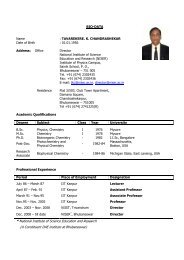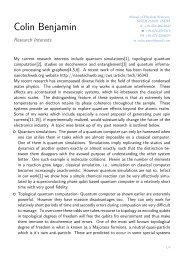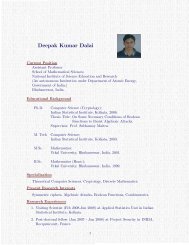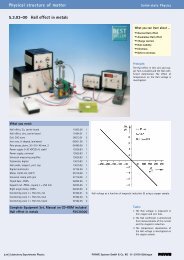Lecture-Notes (Thermodynamics) - niser
Lecture-Notes (Thermodynamics) - niser
Lecture-Notes (Thermodynamics) - niser
You also want an ePaper? Increase the reach of your titles
YUMPU automatically turns print PDFs into web optimized ePapers that Google loves.
36 CHAPTER 4. ENTROPY AND SECOND LAW OF THERMODYNAMICS<br />
Using (4.6), we get<br />
<br />
∂P<br />
∂T V<br />
where<br />
= −<br />
α = 1<br />
<br />
∂V<br />
V ∂T P<br />
kT = − 1<br />
<br />
∂V<br />
V ∂P T<br />
kS = − 1<br />
<br />
∂V<br />
V ∂P<br />
<br />
∂z<br />
= −<br />
∂x y<br />
∂f/∂x<br />
∂f/∂z .<br />
1<br />
(∂T/∂V ) P (∂V/∂P) T<br />
S<br />
= − (∂V/∂T) P<br />
(∂V/∂P) T<br />
= α<br />
kT<br />
(coefficient of thermal expansion),<br />
(isothermal compressibility),<br />
(adiabatic compressibility).<br />
We substitute in<br />
<br />
∂U<br />
δQ = TdS = CV dT + + P dV<br />
∂V T<br />
expressions (4.7) and (4.5) and get the following useful relations.<br />
, (4.7)<br />
1) The absorbed heat is expressed in terms of directly measurable coefficients as<br />
where T and V are independent variables.<br />
2) If T and P are used as independent variables, then<br />
δQ = TdS = CV dT + α<br />
TdV , (4.8)<br />
kT<br />
TdS = CPdT − αTV dP (4.9)<br />
3) If V and P are used as independent variables, dT can be rewritten in terms of dV<br />
and dP as<br />
<br />
∂T ∂T<br />
dT = dV + dP =<br />
∂V P ∂P V<br />
1 kT<br />
+ dP .<br />
αV α<br />
The corresponding TdS equation is then<br />
TdS = CP<br />
dV +<br />
αV<br />
CPkT<br />
α<br />
<br />
− αTV dP . (4.10)<br />
There is also an important connection between CP and CV (which follows from eq.<br />
(4.8) and (4.9)):<br />
CP − CV = α2<br />
TV = −T<br />
kT<br />
<br />
∂V 2<br />
∂T P<br />
∂V<br />
∂P T<br />
> 0 . (4.11)







